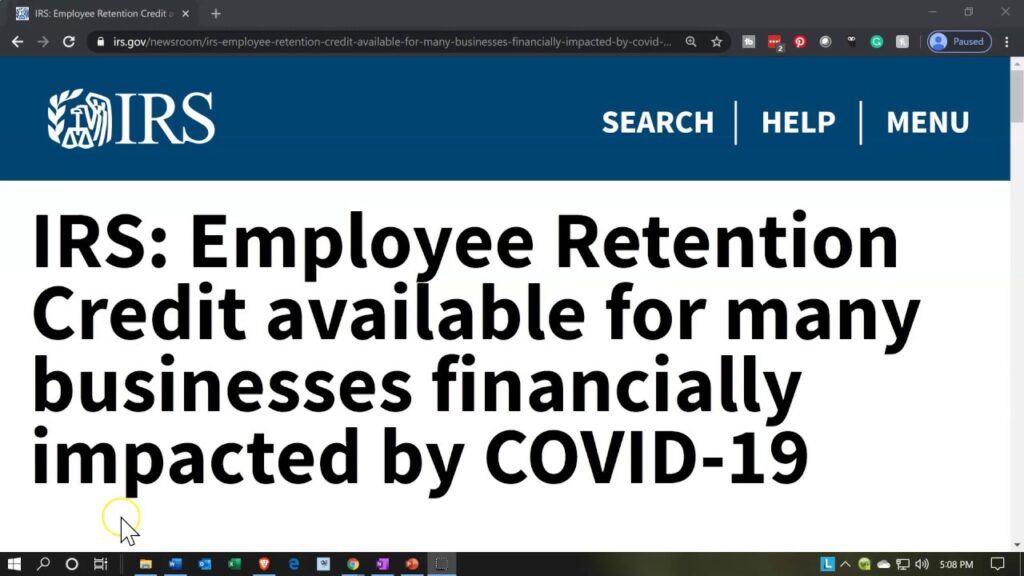In IR-2021-21, issued on January 26, 2021, the Internal Revenue Service encourages employers to take advantage of the newly-extended Employee Retention Credit (ERC), which makes it easier for businesses that have chosen to keep their employees on the payroll despite economic and operational challenges posed by COVID-19.
The Taxpayer Certainty and Disaster Tax Relief Act of 2020, enacted December 27, 2020, as part of the Consolidated Appropriations Act, 2021, made a number of important changes to the employee retention tax credits previously made available under the Coronavirus Aid, Relief, and Economic Security Act (CARES Act). The reach of these changes is broad and should prove advantageous for many employer/taxpayers. Several of the changes apply only to 2021, while others apply to both 2020 and 2021. (see related post)
Among the most important of the changes are those modifying and extending the ERC for six additional months, through June 30, 2021. Under the new modified rules, eligible employers can now claim a refundable tax credit against the employer share of Social Security tax equal to 70% of the qualified wages they pay to employees during the period after December 31, 2020, through June 30, 2021.
Moreover, retroactive to the March 27, 2020, enactment of the CARES Act, the law now allows employers who received Paycheck Protection Program (PPP) loans to also claim the ERC for qualified wages that are not treated as payroll costs in obtaining forgiveness of the PPP loan. It is important to note that those wages considered qualified in the first quarter of 2021 for purposes of determining one’s ERC cannot be counted again in consideration of the forgiveness of a Second Draw PPP loan. (view our webinar for more discussion of these topics)
ERC Eligibility Criteria for Employers
Effective January 1, 2021, employers are eligible to claim the tax credit if they operate a trade or business during January 1, 2021, through June 30, 2021, and experience either of the following two circumstances:
- A full or partial suspension of the operation of their trade or business during this period because of governmental orders limiting commerce, travel or group meetings due to COVID-19; or
- A decline in gross receipts in a calendar quarter in 2021 where the gross receipts of that calendar quarter are less than 80% of the gross receipts in the same calendar quarter in 2019 (prior to the changes, to be an eligible employer required a 50% decline in gross receipts in 2020).
Employers that did not exist in 2019 can use the corresponding quarter in 2020 to measure the decline in their gross receipts. In addition, for the first and second calendar quarters in 2021, employers may elect in a manner provided in future IRS guidance to measure the decline in their gross receipts using the immediately preceding calendar quarter (i.e., the fourth calendar quarter of 2020 and first calendar quarter of 2021, respectively) compared to the same calendar quarter in 2019.
Expanded Definition of Qualified Wages
In addition, effective January 1, 2021, the definition of qualified wages has been changed to provide:
- For an employer that averaged more than 500 full-time employees in 2019, qualified wages are generally those wages paid to employees that are not providing services because operations were fully or partially suspended or due to the decline in gross receipts.
- For an employer that averaged 500 or fewer full-time employees in 2019, qualified wages are generally those wages paid to all employees during a period that operations were fully or partially suspended or “during the quarter” that the employer had a decline in gross receipts regardless of whether the employees are providing services.
Note, for determining the eligibility of an employer in the first quarter of 2021, a comparison is permitted wherein the fourth quarter of 2020 can be compared to the fourth quarter of 2019 to determine if the wages in the first quarter of 2021 qualify for the credit. This accommodation allows for early refunds and assistance to employers through the use of the ERC.
Qualified wages are limited to $10,000 per employee per calendar quarter in 2021. Thus, the maximum ERC amount available to employers in 2021 is $7,000 per employee per calendar quarter, for a total of $14,000.
Claiming the Credit
Employers can access the ERC for the first and second quarters of 2021 prior to filing their employment tax returns by reducing employment tax deposits. Small employers (with an average of 500 or fewer FTEs in 2019) may request advance payment of the credit (subject to certain limits) on Form 7200, after reducing deposits. (see related post) In 2021, advances are not available for employers larger than this.
In the release, the IRS directs employers to the COVID-19-Related Employee Retention Credits: How to Claim the Employee Retention Credit FAQs, which guides employers through the mechanical process of claiming the credits. Note, however, because the FAQs are not published as part of the Internal Revenue Bulletin, the information set forth in the FAQs cannot be used as legal support for a tax position in a court of law. Unfortunately, the noted guidance is all that is available for employers/taxpayers to use in obtaining the credit.
Final Thoughts
Grossman Yanak & Ford LLP has been very active in interpreting the advantageous provisions of the recent COVID-relief package. If you have questions or need assistance with the ERC, or any other component of the legislation enacted in December, please feel free to contact Bob Grossman, Don Johnston or Mike Weber at 412-338-9300.
Related Posts:
Tax Forms Available to Obtain Stimulus Credits (Including the ERC)
Consolidated Appropriations Act, 2021 Enhances the Employee Retention Credit
Retroactive and Expanded Employee Retention Credit Opportunities








